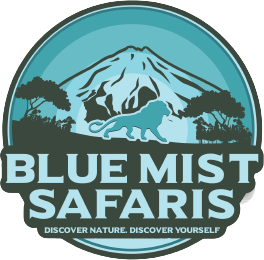- +255626220000
- 10665 Arusha Tanzania
- info@bluemistsafaris.com

Kilimanjaro National Park is a Tanzanian national park, located 200 miles south of the equator in Kilimanjaro Region, Tanzania. The national park is located near the city of Moshi. The park includes the whole of Mount Kilimanjaro above the tree line and six forest corridors stretching down through the montane forest belt. It covers an area of 753 km2 (291 sq mi) from 2°45’–3°25’S, 37°00’–37°43’E. The park is administered by the Tanzania National Parks Authority.
A variety of animals can be found in the park. Above the timberline, Kilimanjaro tree hyrax, a vulnerable species, common duiker and rodents are frequently encountered. Another vulnerable species, Abbott’s duiker, is restricted to Kilimanjaro and some neighboring mountains. In the montane forests among others, blue monkey, western black and white colobus, bushbaby, and leopards can be found.
Mount Kilimanjaro
Kilimanjaro, with its three volcanic cones, Kibo 5,895 m (19,341 ft), Mawenzi 5,149 m (16,893 ft), and Shira 3,962 m (13,000 ft), is a dormant volcanic mountain in Kilimanjaro National Park, Kilimanjaro Region, Tanzania. It is the highest mountain in Tanzania, the highest mountain in Africa, and the highest free-standing mountain in the world at 5,895 meters or 19,341 feet above sea level (the Uhuru Peak/Kibo Peak). A private organization in February 2013 designated Mount Kilimanjaro as one of the seven natural wonders of Africa.
There are six official trekking routes by which to climb Mt Kilimanjaro, namely: Marangu, Rongai, Lemosho, Shira, Umbwe and Machame. Of all the routes, Machame is by far the most scenic albeit steeper route up the mountain, which can be done in six or seven days. The Rongai is the easiest and least scenic of all camping routes with the most difficult summit night and the Marangu is also relatively easy, but accommodation is in shared huts with all other climbers. As a result, this route tends to be very busy, and ascent and descent routes are the same.
Being an Afromontane sky island, Kilimanjaro has enormous biodiversity while low in endemic species. However endemics include the giant groundsels in the bunchgrass tussock grasslands, and other flora adapted to living in alpine plant conditions.
Kilimanjaro has a large variety of forest types over an altitudinal range of 3,000 m (9,843 ft) containing over 1,200 vascular plant species. Montane Ocotea forests occur on the wet southern slope. Cassipourea and Juniperus forests grow on the dry northern slope. Subalpine Erica forests at 4,100 m (13,451 ft) represent the highest elevation cloud forests in Africa. In contrast to this enormous biodiversity, the degree of endemism is low. However, forest relicts in the deepest valleys of the cultivated lower areas suggest that a rich forest flora inhabited Mt Kilimanjaro in the past, with restricted-range species otherwise only known from the Eastern Arc mountains. The low degree of endemism on Kilimanjaro may result from destruction of lower elevation forest rather than the relatively young age of the mountain.
Another feature of the forests of Kilimanjaro is the absence of a bamboo zone, which occurs on all other tall mountains in East Africa with a similarly high rainfall. Sinarundinaria alpina stands are favoured by elephants and African buffalos elsewhere. On Kilimanjaro these megaherbivores occur on the northern slopes, where it is too dry for a large bamboo zone to develop. They are excluded from the wet southern slope forests by topography and humans, who have cultivated the foothills for at least 2000 years.
This interplay of biotic and abiotic factors could explain not only the lack of a bamboo zone on Kilimanjaro but also offers possible explanations for the patterns of diversity and endemism. If true, Kilimanjaro’s forests would serve as a striking example of the large and long-lasting influence of both animals and humans on the African landscape.
Experience Africa’s breathtaking landscapes on a wildlife safari, and discover ancient wonders on trips to Tanzania and Zanzibar island with Blue Mist Safaris, Safari journeys are a wonderful way to experience Africa for the first time.
 Mahamood M Hersi2023-07-19Jag hade väldigt trevligt upplevelse tillsammans med mina barn, resan var väl organiserad och vänlig
Mahamood M Hersi2023-07-19Jag hade väldigt trevligt upplevelse tillsammans med mina barn, resan var väl organiserad och vänlig Ahmed Saleh2023-03-23On my first ever visit to Africa, I went to Kilimanjaro with Blue Mist Safaris. I appreciate the efforts the owner made to ensure the adventure was exciting and memorable for all of us. I will definitely come again and go on a safari.
Ahmed Saleh2023-03-23On my first ever visit to Africa, I went to Kilimanjaro with Blue Mist Safaris. I appreciate the efforts the owner made to ensure the adventure was exciting and memorable for all of us. I will definitely come again and go on a safari. Hassan Abdillah2023-03-10Thanks Blue Mist Safaris for organizing our Zanzibar and safari trips. It was amazing experience and I'd definitely return.
Hassan Abdillah2023-03-10Thanks Blue Mist Safaris for organizing our Zanzibar and safari trips. It was amazing experience and I'd definitely return. A Sarah2023-03-10One of the best holidays. Thank you Bluemist safaris team for the great experience and memories made in Tanzania.Google rating score: 5.0 of 5, based on 4 reviews
A Sarah2023-03-10One of the best holidays. Thank you Bluemist safaris team for the great experience and memories made in Tanzania.Google rating score: 5.0 of 5, based on 4 reviews
At Blue Mist Safaris, we aim to bridge the gaps between comfort, fun and affordability while participating in efforts to support local communities, protect the natural environment and conserve wildlife in Tanzania.
At Blue Mist Safaris, we aim to bridge the gaps between comfort, fun and affordability while participating in efforts to support local communities, protect the natural environment and conserve wildlife in Tanzania.